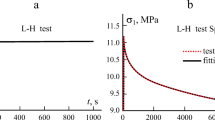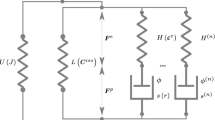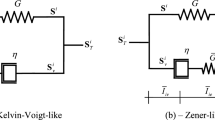Abstract
This contribution aims at achieving two important goals: First, it outlines a numerical inverse homogenization strategy able to recover material parameters of the microstructure by using results of macroscopic tests. Second, it considers parameter identification for viscoelastic heterogeneous materials, which is a step providing the basis for the further extension toward the general treatment of dissipative processes. The approach proposed couples the Levenberg–Marquardt method with the multiscale finite element method. In this combination, the former is a gradient-based optimization strategy used to minimize a merit function while the latter is a numerical homogenization technique needed to solve the direct problem. The specific example studied in the paper deals with the investigation of a composite consisting of a viscoelastic curing polymer and a nonlinear elastic material. It proposes a three-step procedure for the evaluation of its material parameters and discusses the accuracy and the uniqueness of the solution.






Similar content being viewed by others
References
Bazaraa MS, Sherali H, Shetty CM (2006) Nonlinear programming: theory and algorithms. Wiley, New York
Buchanan J, Gilbert RP (2007a) Determination of the parameters of cancellous bone using high frequency acoustic measurements. Math Comp Model 45:231–308
Buchanan J, Gilbert RP (2007b) Determination of the parameters of cancellous bone using high frequency acoustic measurements II: inverse problems. J Comput Acoust 15(2):199–220
Buchanan J, Gilbert RP, Ou Y (2011) Recovery of the parameters of cancellous bone by inversion of effective velocities, and transmission and reflection coefficients. Inverse Probl 27(12):125,006 (1-23)
Burczyrński T, Kuś W (2008) Identification of material properties in multiscale modelling. J Phys: Conf Ser 135(1):012,025
Cherkaev E (2001) Inverse homogenization for evaluation effective properties of a mixture. Inverse Probl 17:1203–1218
Feyel F (2003) A multilevel finite element method (FE\(^2\)) to describe the response of highly nonlinear structures using generalized continua. Comput Methods Appl Mech Eng 192:3222–3244
Feyel F, Chaboche JL (2000) FE\(^2\) multiscale approach for modelling the elastoviscoplastic behavior of long fibre SiC/Ti composite materials. Comput Methods Appl Mech Eng 183:309–330
Fish J, Ghouali A (2001) Multiscale analytical sensitivity analysis for composite materials. Int J Numer Meth Eng 50(6):1501–1520
Ghouali MA, Duvaut G, Ortola S, Oster A (1998) Local analytical design sensitivity analysis of the forging problem using FEM. Comput Meth Appl Mech Eng 163:55–70
Haftka R, Gürdal Z, Kamat MP (1992) Elements of structural optimization. Kluwer Academic Publishers, Dordrecht
Haftka RT, Grandhi RV (1986) Structural shape optimization—a survey. Comput Meth Appl Mech Eng 57(1):91–106
Haug EJ, Arora JS (1978) Design sensitivity analysis of elastic mechanical systems. Comput Meth Appl Mech Eng 15:35–62
Haug EJ, Choi KK, Komkov V (1986) Design sensitivity analysis in structural systems. Academic Press, New York
Haupt R, Haupt SE (2004) Practical genetic algorithms. Wiley, Hoboken
Hill R (1963) Elastic properties of reinforced solids: some theoretical principles. J Mech Phys Solids 11:357–372
Hill R (1972) On constitutive macro-variables for heterogeneous solids at finite strain. Proc R Soc Lond A 326:131–147
Hossain M, Possart G, Steinmann P (2009) A finite strain framework for the simulation of polymer curing. Part I: elasticity. Comput Mech 44:621–630
Hossain M, Possart G, Steinmann P (2010) A finite strain framework for the simulation of polymer curing. Part II. Viscoelasticity and shrinkage. Comput Mech 46:363–375
Ilic S, Hackl K (2009) Application of the multiscale FEM to the modeling of nonlinear multiphase materials. J Theor Appl Mech 47:537–551
Ilic S, Hackl K, Gilbert R (2010) Application of the multiscale FEM to the modeling of cancellous bone. Biomechan Model Mechanobiol 9(1):87–102
Kirsh U (1993) Structural optimization. Fundamentals and applications. Springer-Verlag, Berlin
Klinge S (2012a) Inverse analysis for multiphase nonlinear composites with random microstructure. Int J Multiscale Comp Eng 10(4):361–373
Klinge S (2012b) Parameter identification for two-phase nonlinear composites. Comput Struct 108–109:118–124
Klinge S (2013) Determination of the geometry of the RVE for cancellous bone by using the effective complex shear modulus. Biomechan Model Mechanobiol 12(2):401–412
Klinge S, Hackl K (2012) Application of the multiscale FEM to the modeling of nonlinear composites with a random microstructure. Int J Multiscale Comp Eng 10(3):213–227
Klinge S, Bartels A, Steinmann P (2012a) Modeling of curing processes based on a multi-field potential. Single- and multiscale aspects. Int J Solid Struct 49:2320–2333
Klinge S, Bartels A, Steinmann P (2012b) The multiscale approach to the curing of polymers incorporating viscous and shrinkage effects. Int J Solid Struct 49:3883–3900
Kohli HS, Carey GF (1993) Shape optimization using adaptive shape refinement. Int J Numer Meth Eng 36(14):2435–2452
Levenberg K (1944) A method for the solution of certain problems in least squares. Quart Appl Math 2:164–168
Luenberger D, Ye Y (2008) Linear and nonlinear programming. Springer Publications, New York
Mahnken R (2013) Thermodynamic consistent modeling of polymer curing coupled to viscoelasticity at large strains. Int J Solid Struct 50:203–2021
Mahnken R, Stein E (1996a) Parameter identification for viscoplastic models based on analytical derivatives of a least-squares functional and stability investigations. Int J Plast 12(4):451–479
Mahnken R, Stein E (1996b) A unified approach for parameter identification of inelastic material models in the frame of finite element method. Comput Meth Appl Mech Eng 136:225–258
Marquardt D (1963) An algorithm for least-squares estimation of nonlinear parameters. SIAM J Appl Math 11:431–441
Miehe C, Schröder J, Schotte J (1999) Computational homogenisation analysis in finite plasticity, simulation of texture development in polycrystalline materials. Comp Met Appl Mech Eng 171:387–418
Miehe C, Schotte J, Lambrecht M (2002) Homogenisation of inelastic solid materials at finite strains based on incremental minimization principles. J Mech Phys Solids 50:2123–2167
Musayev K, Hackl K, Baitsch M (2013) Frequency domain waveform inversion in a tunnel environment. PAMM 13(1):323–324
Nocedal J, Wright SJ (1999) Numerical optimization. Springer-Verlag, Wien
O’Brien DJ, Sottos NR, White SR (2007) Cure-dependent viscoelastic Poisson’s ratio of epoxy. Exp Mech 47:237–249
Oskay C, Fish J (2008) On calibration and validation of eigendeformation-based multiscale models for failure analysis of heterogenepous systems. Comput Mech 42:181–195
Press WH, Teukolsky SA, Vetterling WT, Flannery BP (1992) Numerical recipies in fortran. Cambridge University Press, Cambridge
Reese S, Govindjee S (1998) A theory of finite viscoelasticity and numerical aspects. Int J Solid Struct 35:3455–3482
Rojas R (1996) Neural networks. Springer-Verlag, Berlin
Schmidt U, Mergheim J, Steinmann P (2012) Multiscale parameter identification. Int J Multiscale Comp Eng 10(4):327–342
Schmidt U, Mergheim J, Steinmann P (2014) Identification of elastoplastic microscopic material parameters within a homogenization scheme. Int J Numer Methods Eng (submitted)
Simo J, Hughes TJR (1998) Computational inelasticity. Springer Verlag, New York
Sokolowski J, Zolesio J (1992) Introduction to shape optimization. Shape sensitivity analysis. Springer-Verlag, New York
Sundararaghavan V, Zabaras N (2006) Design of microstructure-sensitive properties in elasto-viscoplastic polycrystals using multiscale homogenization. Int J Plast 22(10):1799–1824
Tschoegl NW (1989) The phenomenological theory of linear viscoelastic behavior. An introduction. Springer, Berlin
Vidal CA, Haber RB (1993) Design sensitivity analysis for rate-independent elastoplasticity. Comput Meth Appl Mech Eng 107:393–431
Yu X, Gen M (2010) Introduction to the evolution algorithms. Springer-Verlag, New York
Zienkiewicz O, Taylor R (2000) The finite element method. Butterworth-Heinemann, Oxford
Zohdi TI (2003) Constrained inverse formulation in random material design. Comput Meth Appl Mech Eng 192:3179–3194
Acknowledgments
The second author acknowledges funding by the ERC-Advanced Grant MOCOPOLY.
Author information
Authors and Affiliations
Corresponding author
Rights and permissions
About this article
Cite this article
Klinge, S., Steinmann, P. Inverse analysis for heterogeneous materials and its application to viscoelastic curing polymers. Comput Mech 55, 603–615 (2015). https://doi.org/10.1007/s00466-015-1126-5
Received:
Accepted:
Published:
Issue Date:
DOI: https://doi.org/10.1007/s00466-015-1126-5




